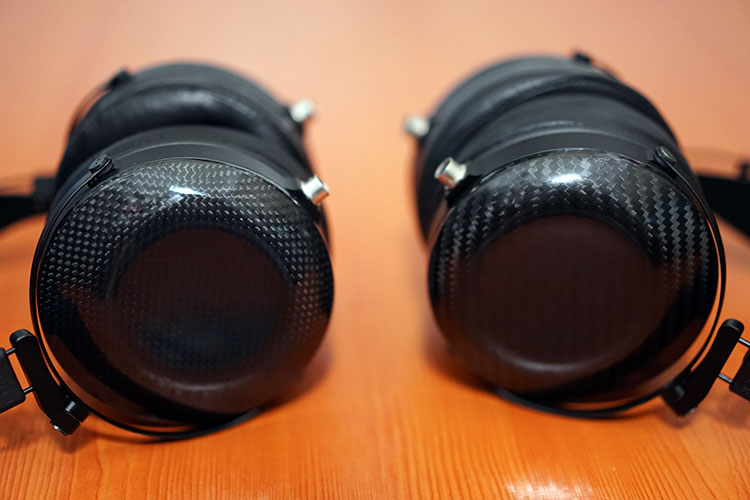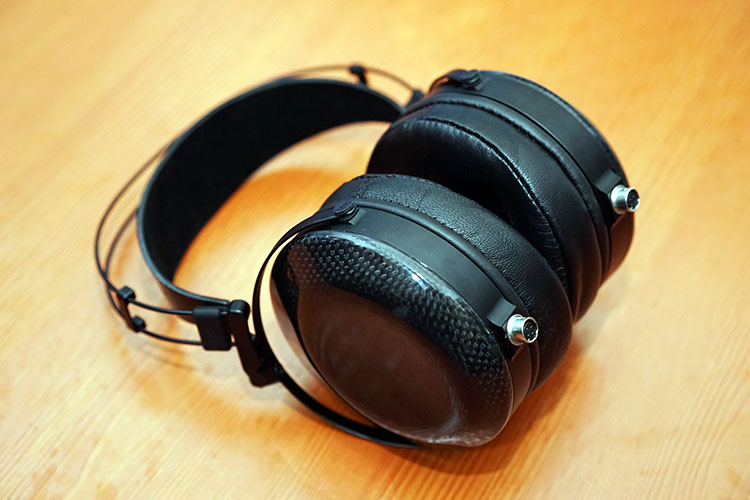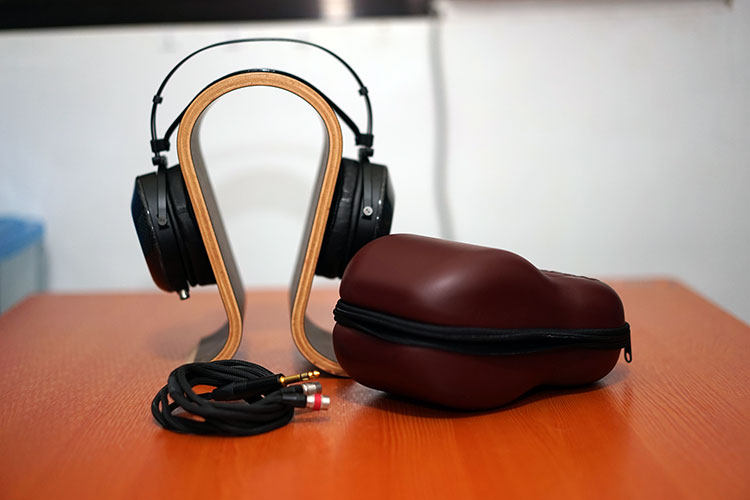This is a review of the Dan Clark Audio Ether C Flow, which is the company’s flagship closed-back circumaural headphones featuring TrueFlow technology. It is priced at $1799.
Disclaimer: This sample was sent to us is a sample in exchange for our honest opinion. Headfonics is an independent website with no affiliate links or services. We thank the team at Dan Clark Audio for giving us this opportunity.
To read more about Dan Clark Audio products we featured on Headfonics click here.
Note, that this article follows our scoring guidelines which you can read up on here.
Change can sometimes be evolutionary and yet dramatic at the same time. However, when DCA suggested I upgrade my Top Gear 2015 Ether C headphones to the new $1799 Flow edition citing a major (read dramatic) enhancement to the sound plus a brand new (read evolutionary) design, I resisted for a while.
I had my own twisted logic for this. I had spent the best part of 8 months with the Ether C using it for casual and considered listening. I was not sure if I wanted to disrupt that enjoyable equilibrium. The Ether C has its own space among the other headphones I use regularly and I was solidly referencing it for most of my work to great effect.
Eventually, I decided to explore what the new C Flow had to offer, and to be frank I am glad I did. It has a little something the Ether C is missing in the v1 and v1.1 format that can make a big tonal difference and yet, at the same time, I am also glad the Ether C v1.1 is still an option because I think there is room for it also on the shelf beside the Flow.
Is the Flow better? It is, but I can’t help but feel the tug of the Ether C on certain days. Honestly, this is the best of both worlds.
What Is The Pitch?
It is DCA’s flagship closed headphone, it costs $1799 (DUM cable as standard) and it comes packed with their latest technology, called TrueFlow.
TrueFlow is designed to enhance the staging qualities of the Ether C, as well as bring in a bit of low-end beef that even I will admit is lacking on the Ether C and supposedly superior resolution. The V-Planar(TM) driver from the original Ether C is still in place.
In short, Flow is all about a better listening experience and a certain type of experience that a lot of people thought was missing from the otherwise excellent original Ether C.
TrueFlow
Our new ETHER Flow headphones feature TrueFlow technology which smooths the path for air moving into, through, and out of the magnet structure* for greatly reduced distortion and improved dynamics. (Dan Clark Audio Website)
Stats & Planars
The concept for TrueFlow came out of studying electrostatic design properties and what makes electrostatic cans tick. In particular, with the way stats managed airflow to get that super fast detailed sound.
Those with eagle eyes will know DCA is indeed working on a new electrostatic project so it is not beyond reason to think both planar and electrostatic design concepts can and will bump into each other in the office and beyond.
Defining the Problem
One of those is the fact both designs actually use a planar diaphragm though beyond that stats do not use magnets, they instead use tiny perforated and very thin stators. Contrast this with the much thicker angular magnets used by planars and right away planar headphones are faced with bigger airflow management challenges.
Those magnets create punishing angles for air to navigate causing a measure of diffraction and generally the disorderly flow of air that results in a loss of detail and higher than expected levels of distortion in the audio signal.
The TrueFlow Solution
What needed to happen was to produce a smoother, easier flow of air and with that, Dan’s team came up with the TrueFlow waveguide technology to assist in that process. Essentially by blending those harsh angles into gentler waveguide constructs the air will flow more smoothly within the planar magnetic design.
Not just on the inside directly onto the magnets but also on the outside so the process is clean and smooth at both the point of entry for the air and the point of distribution. (If you note in the video above the waveguide TrueFlow design is green-shaped around the planar magnet inlets.)
Design
Form Factor
The Ether C Flow is still that same “timeless” design Dan was after back when the Ether C was originally released. The ‘evolution and drama’ is 99% on the inside of this headphone so you won’t see a huge difference between the Flow and Ether C in terms of form factor.
That uber-comfortable fit remains intact and whilst 390g is not lightweight it is in fact almost the exact same as the AKG K812 and K872 dynamic flagships so the days of planars weighing a ton are long since gone.
At the time of writing, it’s really only the Audeze LCD line and the old Hifiman HE first-gen planars that generally carry that weight association.
Materials
The cups are still made from carbon fiber but this time DCA has changed the weave design to differentiate between the original Ether C and the Flow C (should they occupy the same space at the same time kind of thing).
From the picture below you can see the Ether C Flow on the left and the Ether C on the right and their differing carbon fiber weave patterns.
Apart from that nothing else major has changed. The headband is still made from very minimal but strong NiTinol “memory metal”. The rest is made up of an aluminum baffle, pivots, and gimbals.
The NiTinol is really thin actually, almost reminds me of the old AKG K series framing but much stronger and very light indeed. DCA has taken that comfy headband strap they used in the Alpha series and placed it under this NiTinol frame for comfort and balance and added adjusters on either side for fitting purposes.
These adjusters operate within about 2 inches of space so they should cope with most head sizes. The tensioner joint that holds the strap and NiTinol bands just has one small cosmetic change with the word Flow now replacing Ether.
Cables
“Distinctly-un-magical” has now been absorbed into the price of the Ether C Flow so now you get the hirose terminated dual entry DUM cable as standard.
You can, of course, elect to choose what termination and length at the checkout online and there are plenty of options from the quarter jack, 2.5mm balanced, 3.5mm unbalanced, and 4-pin XLR balance.
You can have a 10ft cable option also though going 10ft will add an additional $50 to the final price. The mandatory DUM cable choice is a wise move as they are infinitely superior to the old stock rubber cable being lighter and more pliant to work with.
Comfort & Isolation
Of course, you can’t talk about DCA headphones without mentioning the pads because just about every headphone I have tried from them has always come with sumptuous pads.
The Ether C Flow continues that legacy and has the same excellent, deep, and soft design as the Ether C edition. Note however the leather has had a bit of an “upgrade”. The Flow pads are now Italian NAPPA lamb leather – swanky!
The C Flow only comes with angular pads, no more flat pads. This is now standard and they have done away with the flat pads option. The comfort is sublime by the way and whilst part of my ear does overlap with the memory foam sides they are so supple you do not even notice.
The seal is excellent as always for a full-sized closed headphone and the fit is very secure indeed. The clamping pressure of the new NiTinol frame combined with the lambskin pads is probably one of the best in the business for my money.
There is no lateral movement once you get the right headband adjustment for your head and they never feel they will slide off or lose pressure.
Accessories & Packaging
With the Ether range, Dan ditched the old velvet cloth pouch and went with a far superior contoured headphone case that reminds me of the V-Moda cases but only a little more executive level.
It has enough room to carry one or two cables and seems pretty durable. Certainly not on the level of the tank-like LCD waterproof carry cases but a lot more discreet and does not take up a lot less room and weight.
The box itself is quite similar to the original Ether C box with the only change being the bold white decal stating “Flow” on the front and bottom.
Aside from the case you get your Certificate of Authenticity, note you get 2 years parts and labor warranty on the Ether C Flow, as well as a microfiber cloth to keep your cups nice and shiny and a little manual.
Sound Impressions
Summary
The Ether C Flow plugs some of the gaps in the Ether C’s otherwise impressively neutral presentation. There is now a much higher degree of PRaT and low-end power in the Flow’s tonal response which is a little more u-shaped than the original.
Whereas before the Ether C came across as accurate and coherent you could argue that, even with v1.1, the detail and texture of the low end didn’t stand out as much as they could.
You can get around that with some judicious use of EQ but it was not its stock sound. Imagine, if you will, not having to add some low-end EQ on the Ether C, and instead not only does it come as standard but you also get an upgrade in resolution and detail along with it. The Flow now has that low-end body that was missing before.
The Flow has also directly tackled the other slight issue I had with the Ether C’s treble performance. I mentioned previously in my Ether C review that on some setups and genres, the treble would tend to get a touch peaky and thin-sounding.
I normally compensated for this with a tube setup or again some 1-2DB drop in that area using EQ on a more neutral solid-state amp. This time the treble of the Flow has smoothed out with a more even plateau post 5k than the older C.
What does this mean? Yup, it retains sparkle and some excellent energy right up to around 11-12k giving me that sought-after extension and “hifi” sound but I also get a more controlled lower to the mid-treble performance that sounds more natural and far less peaky.
Now the Flow is a more flexible headphone for system setups than before and I have less need to EQ to adjust to various system configurations.
Bass
All the way up to 130Hz the C flow’s response has been upped by around 2-3dB with particular emphasis around 50Hz to 100Hz and a smidgen beyond.
The response curve of the sub-bass still matches that of the Ether C despite the additional gain so the impressive sub-bass response of the old Ether C in terms of extension and characteristics remains intact but now you get some additional rumble and low-end detail as a result.
The bigger departure from the Ether C response curve is the mid-bass elevation in the new Flow. Again this is around 2-3dB over the old C but the Ether C response was always much flatter and a little leaner.
This elevation continues right up to that 100Hz marker before it drops down quickly to 200Hz (lower mids) and a smaller bump thereafter to 300Hz that gives a nice bit of body without loss of clarity to lower key instruments.
It is important to note though that the bass remains tight and quick. Dan has not softened this up or thrown in additional warmth to slow it down or longer lingering decays. The bass on the Flow is certainly more aggressive and punchy sounding now but it’s not in any way bloated or overcooked. It retains an impressive level of detail throughout.
Mids
The mid response on the Flow from 1-3k has not changed too much in terms of emphasis compared to the old C. The peak elevation still stays roughly around the 1k marker on both headphones with a gentle drop to around 4k upper midrange.
Vocals might seem a touch more recessed compared to the Ether C on initial listening but this is more due to the flatter bass response of the C having less presence and allowing the midrange to take a bit more of a center stage and focus.
I don’t perceive there to be any change in the db (- or +) vocal presence of the Flow compared to the C though detail and timbre for me are a bit more natural sounding and it sounds less overshadowed by the peakier treble of the Ether C.
The bigger change in the lower midrange of the Flow with a little additional bump from 200-300Hz over the flatter response of the Ether C. That elevation adds some additional weight to Flows’ instrumental reproduction giving more substance and physicality to guitar work, especially in rock and metal where perhaps the Ether C wasn’t so convincing and thinner by comparison.
Treble
It is fixed – woot! Okay, so more detail then. This was the one area I felt Ether C needed the most tweaking on. It was peaky, a touch thin, and overshadowed the upper mids a bit too much. Percussion work lacked a natural body and didn’t quite have enough articulation and presence at the very extreme end of the upper treble.
The Ether C treble was okay if EQ’ed better, but it presented a somewhat awkward matching challenge at times with that more pronounced peak at 8-10k and then a quick drop-off post 10k that felt too extreme.
The V1.1 pads worked quite well in subduing the peakiness but some combinations muted the detail overly so. The C Flow negates the need for that kind of tweaking out of the box. Gone is the 5-7k dip and then a sudden jump to 8k on the old Ether C, and instead, the Flow brings in a smoother plateaued emphasis from 5k to 10k and less of a drop-off beyond 10k.
This means the sparkle and energy in the Ether C Flow are retained from the older C but the overall tonal response is smoother and more articulate which benefits higher-pitched percussion works in particular. I no longer feel as careful as before in the system matching with the C Flow’s treble response.
Click on page 2 below for synergy & select comparisons






